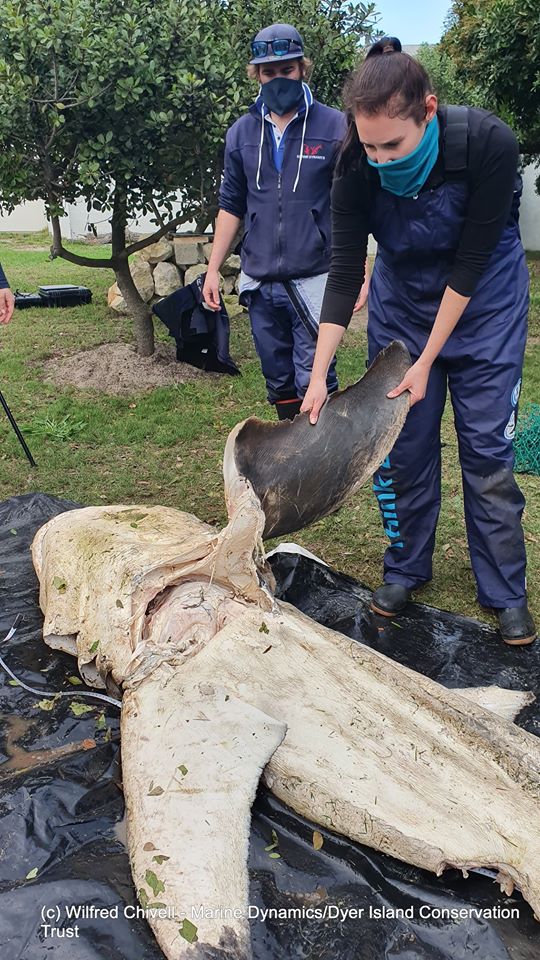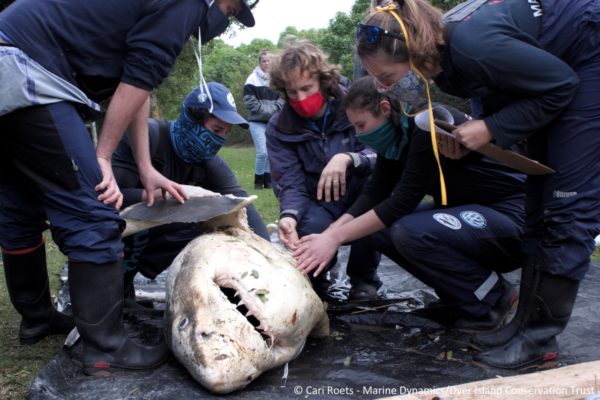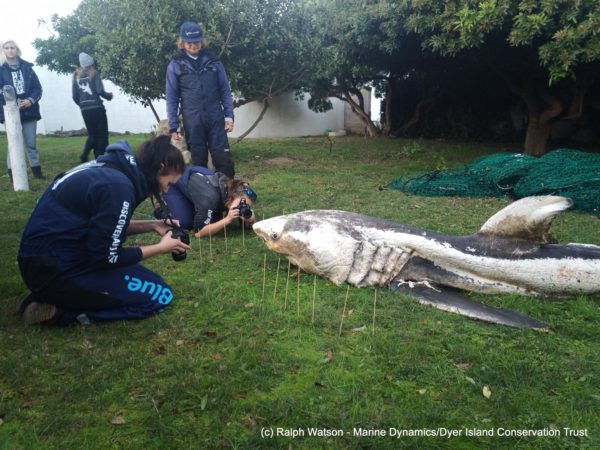The carcass of a great white shark was found on Gansbaai beach on Saturday [July 4]. A team from Marine Dynamics stated that the shark had a large tear between its two pectoral fins and the heart and liver were missing. These injuries have been seen before in other deceased sharks found in Gansbaai and along the coastline.
Two orcas named Port and Starboard have become somewhat famous for their bent dorsal fins and their hearty appetites for sharks. The pair were spotted two days before this carcass washed ashore.
“On July 4, the Marine Dynamics/ Dyer Island Conservation Trust (DICT) was notified by Paul de Villiers of a Great White shark stranding at De Gruis, Gansbaai, South Africa. The carcass was recovered by Marine Dynamics owner, Wilfred Chivell, and his team, and transported to the Marine Dynamics Academy Lodge,” said Marine Dynamics in a Facebook post.

It was clear that the shark had fallen prey to a large predator that was able to tear its body almost effortlessly.
“The following morning a team lead by DICT marine biologists collected detailed measurements, photographic, and biological samples. The white shark was a 3.6 meter female with a large tear between the two pectoral fins with the liver and heart missing – identical injuries to that previously recorded on deceased white sharks in Gansbaai and other shark species found along the coast. Two days prior there were confirmed sightings in False Bay, Cape Town of the orca pair, Port and Starboard, known to predate on various shark species, including white sharks,” recounts Marine Dynamics in a blog post.
Multiple samples were taken by the team and shark bite marks on the body are believed to be consistent with scavenging following the predation that led to the sharks initial death.

In recent years, Cape Town’s waters have been frequented by orcas. Initially, their presence were believed to be responsible for the disappearance of great white shark activity in False Bay. This has been refuted and Marine Dynamic explained the other factors responsible for the lack of great white sightings.
“We believe that commercial overfishing and removal of prey species has a critical impact on the number of white sharks and we are encouraged by the recent selection of an expert panel of scientists to advise the Department of Environmental Affairs, Forestry and Fisheries on addressing this matter.
However, the impact of Orca predations on white sharks in Gansbaai is simply undeniable. It is not a smokescreen for a bigger issue but also linked to pressures other marine species are enduring, adding further urgency to the action on threats affecting the decline of shark stocks along the South African coast,” says Wilfred Chivell, CEO of Marine Dynamics.
“The shark cage diving industry is key to daily monitoring of white sharks that can ultimately advise conservation policy. We have been proactive in setting up our COVID-19 safety protocols so we now await confirmation from government as to when we can start operating.”

The orca’s appetite for sharks has affected the local species from reaching maturity and reproducing.
“We have monitored the behaviour and abundance of white sharks in the area for over 13 years through an established long-term boat-based and tagging data program.
The interactions between orcas and white sharks were first observed in 2017 and seem to occur at similar times each year, although we are only seeing the shark carcasses that wash out, they are all notably larger white sharks, above 3 meters in length. This is concerning for a species that does not reach reproductive maturity until after this size,” says Senior White shark biologist Alison Towner.
“Collaboration between key experts, scientists, and stakeholders are paramount to proactively preserve the future diversity of Southern African shark populations and we thank the members of the public who have provided important information regarding these issues,” she concluded.
Pictures: Marine Dynamics
Credit: Source link